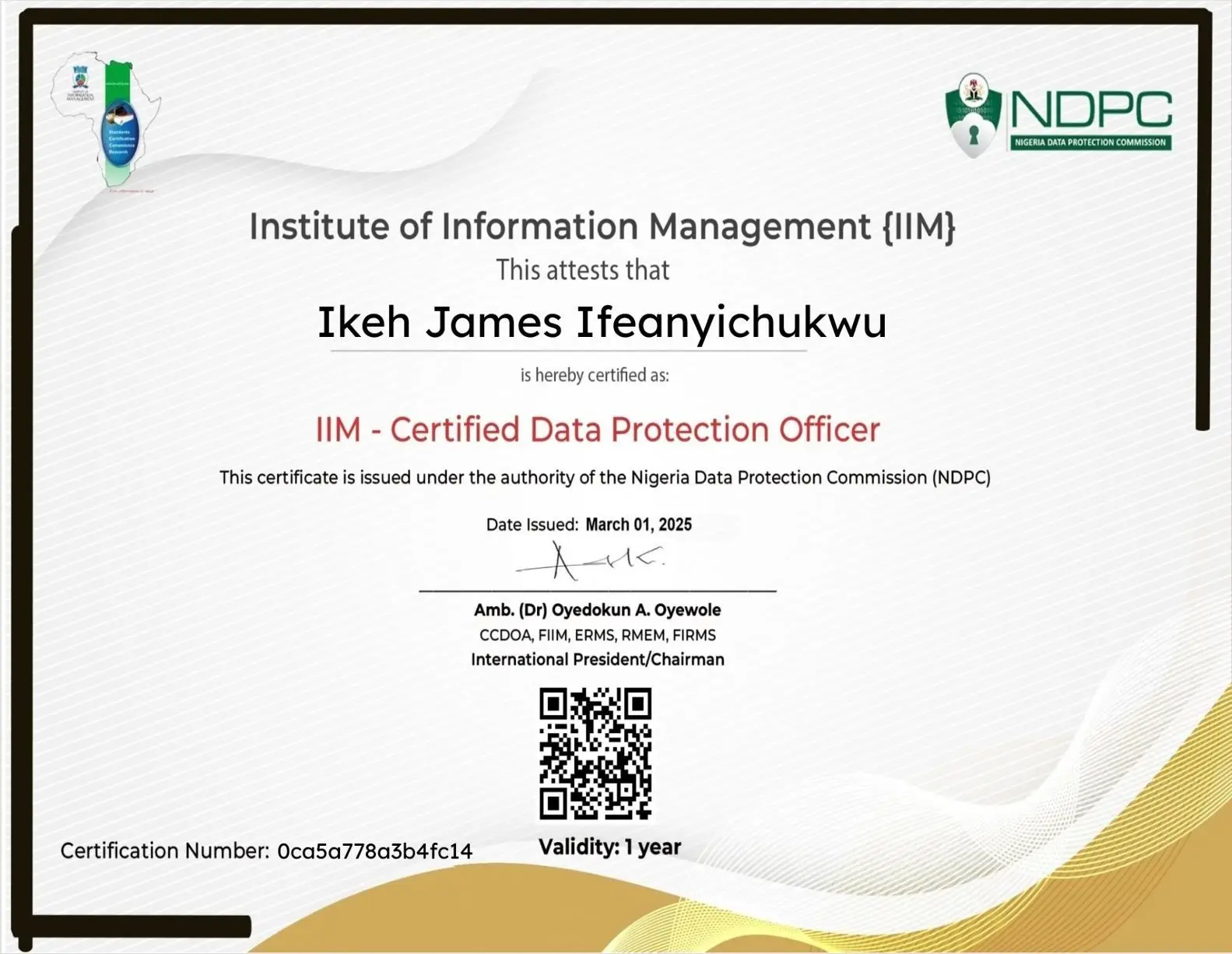How to Integrate Privacy by Design Into Your Tech Stack in 2025 | (Download The PDF Checklist)
Share

In 2025, Privacy by Design (PbD) is no longer a buzzword—it’s a requirement. With stricter regulations like the California Privacy Rights Act (CPRA) in the US, the EU’s GDPR, and the Nigeria Data Protection Act (NDPA 2023), businesses across the globe are under growing pressure to embed privacy and security directly into their technology stack.
Companies that fail to do so face not only regulatory fines but also loss of consumer trust. This article explores how to integrate Privacy by Design into your tech stack, with practical steps, real-world examples, and best practices for compliance in the US, Europe, and Africa.
What Is Privacy by Design?
Privacy by Design (PbD) is a framework developed by Ann Cavoukian, emphasizing that privacy should be built into systems, processes, and technologies from the ground up—not bolted on later.
The 7 Foundational Principles of Privacy by Design
| Principle | What It Means in Practice |
|---|---|
| Proactive, not reactive | Anticipate and prevent data privacy risks before they happen |
| Privacy as the default setting | Collect only the minimum data required; consent should be opt-in |
| Privacy embedded into design | Integrate data protection features into system architecture |
| Full functionality | Ensure privacy without sacrificing usability or business goals |
| End-to-end security | Protect data throughout its entire lifecycle |
| Visibility and transparency | Make privacy practices clear to users and stakeholders |
| Respect for user privacy | Put individuals first in system design |
Why Privacy by Design Matters in 2025
- Regulatory Pressure:
- CPRA (California): Expands consumer rights and creates the California Privacy Protection Agency.
- GDPR (EU): Explicitly requires “data protection by design and by default.”
- NDPA (Nigeria): Mandates privacy-first approaches, giving the Nigerian Data Protection Commission (NDPC) enforcement powers.
- Rising Cyber Threats: Data breaches and identity theft are escalating across all markets.
- Consumer Trust: Users are more privacy-aware; embedding PbD differentiates brands globally.
- Business Efficiency: Fixing privacy issues post-launch is costlier than designing with privacy in mind.
CPRA vs GDPR vs NDPA: Privacy by Design Obligations
| Regulation | Privacy by Design Requirement | Key Obligations for Businesses | Enforcement Body |
|---|---|---|---|
| CPRA (California) | Requires businesses to implement reasonable security and allow consumers to exercise privacy rights | Data minimization, purpose limitation, opt-out of sale/sharing, retention schedules | California Privacy Protection Agency (CPPA) |
| GDPR (EU) | Explicitly requires “data protection by design and by default” (Article 25) | Data minimization, pseudonymization, impact assessments, accountability, lawful basis for processing | Data Protection Authorities (DPAs) in each EU state |
| NDPA (Nigeria) | Requires organizations to integrate privacy-first approaches across data lifecycle | Appointment of Data Protection Officers (DPOs), audits, impact assessments, consent management, cross-border transfer restrictions | Nigeria Data Protection Commission (NDPC) |
Takeaway: If your business implements Privacy by Design principles—data minimization, encryption, transparent consent, and accountability—you’ll meet the baseline requirements of CPRA, GDPR, and NDPA simultaneously.
How to Integrate Privacy by Design Into Your Tech Stack
1. Data Mapping and Inventory
Identify:
- What personal data you collect
- Where it’s stored
- Who has access
- How long it’s retained
Example: A fintech startup mapping onboarding flows found they were storing unnecessary ID copies. By switching to tokenized verification, they reduced CPRA and NDPA compliance risks.
2. Minimize Data Collection
- Collect only the data required by law or business function.
- Adopt data minimization as mandated by GDPR and NDPA.
- Implement auto-deletion policies to comply with CPRA’s retention rules.
3. Use Privacy-Enhancing Technologies (PETs)
- Encryption (AES-256, TLS 1.3).
- Anonymization & Pseudonymization.
- Differential Privacy.
Case Study: Apple’s iOS uses differential privacy—a model aligned with GDPR, CPRA, and NDPA standards.
4. Access Controls and Authentication
- Adopt Zero Trust Architecture.
- Implement role-based access control (RBAC).
- Require multi-factor authentication (MFA).
5. Consent and Transparency
- Build clear consent banners and preference centers.
- Respect withdrawal of consent under NDPA, GDPR, and CPRA.
- Maintain audit trails for regulators.
Example: Netflix provides granular controls for user accounts, aligning with multiple privacy frameworks.
6. Embed Privacy into DevOps (PrivacyOps)
- Integrate privacy checks in CI/CD pipelines.
- Automate compliance with tools like OneTrust or BigID.
- Conduct Privacy Impact Assessments (PIAs) as required under GDPR and NDPA.
7. Train Your Team
- Conduct cross-jurisdictional training (US, EU, Africa).
- Include engineers, compliance officers, and product managers.
- Emphasize case studies of breaches and penalties (e.g., Equifax, Meta, NDPA enforcement actions).
Common Pitfalls to Avoid
- Treating privacy as “US-only” when global frameworks like NDPA and GDPR apply to multinationals.
- Collecting excessive user data “just in case.”
- Ignoring third-party vendors’ compliance standards.
Benefits of Privacy by Design for Businesses
| Benefit | Impact |
|---|---|
| Multi-jurisdictional compliance | Smoother audits under CPRA, GDPR, NDPA |
| Consumer trust | Global brand reputation boost |
| Competitive edge | Differentiation in privacy-first markets |
| Risk reduction | Lower chance of fines or reputational damage |
FAQs on Privacy by Design in 2025
Q1. Is Privacy by Design required under NDPA?
Yes. Section 24 of NDPA emphasizes data protection by default—similar to GDPR’s Article 25.
Q2. How do CPRA and NDPA differ in Privacy by Design obligations?
- CPRA: Strong on consumer rights (opt-out, right to correct, right to delete).
- NDPA: Strong on organizational accountability (Data Protection Officers, audits, impact assessments).
Q3. Can one PbD framework cover CPRA, GDPR, and NDPA?
Yes. If businesses design for data minimization, encryption, consent management, and transparency, they’ll meet the core requirements of all three.
Conclusion
In 2025, Privacy by Design is a global requirement, not just a best practice. Whether your business operates in California under CPRA, the EU under GDPR, or Nigeria under NDPA, embedding privacy-first principles into your tech stack is the surest way to:
- Stay compliant
- Build user trust
- Reduce risks
- Drive innovation
The companies that win the future will be those that treat privacy as strategy, not compliance.




























Leave a Reply